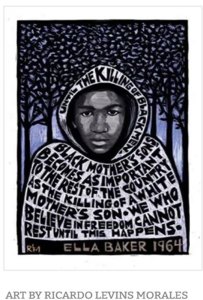Working on the Chain Gang: Prison Labor in 21st Century U.S.
Suzan Koch WAMM Newsletter
The true purpose of the burgeoning penal system is now well-documented—it is the exploitation of inmate labor for the profit of private corporations, which include weapons manufacturers among other industries.
“Prison” by MW
Private prison lobbies, legislative laws, the judiciary, law enforcement, and racism work together to create a system that supplies nearly free labor for the profit of private corporations. And those profiting from this system include all the major weapons manufacturers. How did things get to this point?
To answer that question, it’s important to look at the development of the prison system from its inception following the American Civil War. In reaction to the gains made by freed slaves during Reconstruction, a new system of de facto slavery was created through the quick passage of Southern state and local laws (black codes), ensnaring the new freedmen into penal labor.
This was the beginning, here in America, of the contracting out of mass prison labor to individuals or corporations by state and local governments. Subsequently, in 1936 the federal government passed a law allowing for products to be made in federal prisons by a federal entity now called UNICOR. With the establishment of UNICOR, the practice of using prison labor expanded to encompass federal and state prisons throughout the nation.
The modern-day use of prisoners to produce goods for private companies began in 1979 with the passage of the Prison Industries Enhancement Certification Program (PIE). The legislation was written by the American Legislative Exchange Council (ALEC) that we have heard so much about lately. Members ofALEC also wrote the proposed—and then enacted—enhanced, antidrug crime laws and general felony sentencing guidelines that followed, in conjunction with the Reagan Administration’s “War on Drugs.”
You may subscribe to WAMMToday from this blog website and “Follow” us. WAMMToday is now on Facebook! Check the WAMMToday page for posts from this blog and more! “Like” our page today.
Included were mandatory minimums for nonviolent drug offenders, Three Strikes laws, and Truth in Sentencing laws. In 1995 alone, ALEC’s Truth in Sentencing Act was signed into law in 25 states, thus guaranteeing a burgeoning prison population to be used as almost free labor (currently prisoners earn as little as 23 cents per hour to as much as $1.15 per hour, depending on the skill needed for the job).
 Photo credit: KenStorch. In Maricopa County, Arizona, women prisoners are shackled in chain gangs and bury the decaying bodies of unclaimed indigents under the blazing Arizona sun.
Photo credit: KenStorch. In Maricopa County, Arizona, women prisoners are shackled in chain gangs and bury the decaying bodies of unclaimed indigents under the blazing Arizona sun.
African Americans and Latino/Hispanic Americans have been the primary targets of profit-driven laws. By the year 2000, three-fourths of all prisoners were either black or Hispanic, according to Ken Silverstein in “U.S.: America’s Private Gulag.” This overwhelmingly unequal representation of people of color is in spite of the fact that they comprise a minority of the population (28.9 percent according to the 2010 U.S. Census) and are a significantly smaller percentage found to be in possession of drugs, compared with whites who are stopped while driving.
The deliberate profiling of blacks and Latinos stopped for very minor traffic violations, which would usually be ignored, accounts for the greater percentage prosecuted and imprisoned. Michele Alexander in her book The New Jim Crow describes the institutionalization of this system, which reaches all the way to the U.S. Supreme Court.
Systemic racial profiling, antidrug laws, and harsher sentences have led to a staggering number of prisoners held in U.S. prisons and jails. In fact, the U.S. is number one in the world in actual numbers of prisoners as well as percentage of population. In “Profiteers of Misery: The U.S. Private Prison Industrial Complex” (Interpress News Service,Aug 24, 2011), Kanya D’Almeida stated that “by the end of 2010, the United States was home to 25 percent of the world’s inmates, with roughly 2.4 million people behind bars and over seven million under “correctional supervision.”
 Prison labor began in the U.S.with black codes that ensnared freed slaves into a system of penal labor that included chain gangs.
Prison labor began in the U.S.with black codes that ensnared freed slaves into a system of penal labor that included chain gangs.
Concurrently, there has been a large financial reward for many of those state legislators who helped pass bills allowing state private prisons to be built, as well as private corporation participation to increase in state and federal prisons. In “Follow the Prison Money Trail —Private Prison Companies Invest Millions in Elections,” Silja J.A.Talvi reported that “supposedly, states turn to private companies to cope better with chronic overcrowding and for low-cost management.
However, a closer look suggests a different rationale.” (In These Times, September 4, 2006) The reality is that it is all about the money. The use of racism, profiling, and unfair and unequal sentencing guidelines continually increases the prison population to act as an available source of the cheapest labor possible, with prisoner laborers unprotected by any health and safety regulations and few if any rights in practice that workers are supposed to have if they are employed outside the prison system.
From the start, the private prison industry has been heavily dependent on political connections and campaign contributions to secure the legislation and contracts necessary to “grow” their business. Lobbying by private prison corporations for laws favorable to a “growth industry” is ongoing, and reflects the huge profits that private prison corporations stand to gain from their investment in this expanding market. They are assisted in that growth by ALEC legislation.
One of ALEC’s latest legislative endeavors is Arizona’s SB 1070, which practically makes it mandatory for police to profile brown-skinned people as possible undocumented workers. It was brought to Arizona by ALEC member state Senator Russell Pearce, and serves as a proposed model for other states as well. In an October 28, 2010 NPR report entitled, “Prison Economics Help Drive Arizona Immigration Law,” investigative correspondent Laura Sullivan describes how private prison corporations need new victims to exploit, and have found them in the form of undocumented workers.
The latest news concerning the federal prison labor system, UNICOR, is actually old news—two decades old, but it was only recently uncovered and reported—and this by alternative media: Convict labor is used in the production of high-tech military weapons as well as equipment for soldiers, such as body armor. High-tech weapons parts manufacturing now involves at least 14 federal correctional facilities. The truth has been in plain sight, in the data published by UNICOR, but buried deep because it was divided into a variety of components, not labeled for specific weapons systems. Unless someone understood the technical details of what they were looking for, they wouldn’t realize the scope of high-tech weapons prison production.
 Photo credit: Raytheon
Photo credit: Raytheon
Parts for weapons systems such as Patriot missiles have been made with prison labor, increasing profits for companies like Raytheon and Lockheed Martin.
Another aspect of inmate labor in relation to the military is that prisoners do the cleaning and repair of weapons and equipment, which are often contaminated with highly carcinogenic depleted uranium, and are provided no health and safety protections.
With these cost-cutting production methods, leading U.S. weapons contractors are making huge profits with prison labor. Details are exposed in William Hartung’s book Prophets of War (Nation Books, 2010).
In his article “Why are Prisoners Being Used to Build Patriot Missiles?” Justin Rohrlich reveals just how extensive the use of prison labor by defense contractors really is: “Patriot [missile] assemblers Raytheon and Lockheed Martin aren’t the only defense contractors relying on prison help, by any means…inmates also make cable assemblies for the McDonnell Douglas/Boeing F-15, the General Dynamics/Lockheed Martin F-16, Bell/Textron’s Cobra helicopter, as well as electro-optical equipment for the BAE Systems Bradley Fighting Vehicle’s laser rangefinder.” (Minnyanville.com March 7, 2011)
Further proof of the tremendous profit being made in the prison labor production of high-tech weapons is offered by Noah Shachtman in “Prisoners Help Build Patriot Missiles” (Wired.ComDangerRoom.March 8, 2011). He points out that “the United Arab Emirates is expected to close a deal for $7 billion dollars’ worth of American arms. Nearly half of the cash will be spent on Patriot missiles which cost as much as $5.9 million apiece” and that “some of the workers manufacturing parts for those Patriot missiles are prisoners, earning as little as 23 cents an hour.”
 Photo credit: unknown
Photo credit: unknown
Prison overcrowding is used as a rationale for private corporations to step in and build and manage more prisons. At the same time, they work to increase prison population.
The history of an ever expanding “prison-industrial complex” is one that shows a purposeful, ALEC-driven legislative effort to have private corporations take over as many aspects of the U.S.criminal-justice system as possible, from juvenile detention to maximum security federal prisons and prisons for undocumented workers. The urgent need for prisoners to learn job skills and be rehabilitated is used as a cover, while the true purpose of the penal labor system is now well documented—it is the exploitation of inmate labor for the profit of private prison corporations and weapons manufacturers, among other industries.
In sum: Through the synergy of legislation, institutionalized police profiling, and the judiciary process, the major criminal and justice institutions of the federal government, as well as those of the 50 states, establish and maintain an ever expanding public and private prison system which provides cheap slave/prisoner labor; it is circumventing federal and state wage and hours laws, avoiding health and safety regulations to protect workers, and providing no real incentive on the part of either government-run or private prisons to rehabilitate and release anyone.
So this is where we are now in the United States. We have mass incarceration based on race and class, with private corporations taking over more and more of the penal justice system, from beginning to end. Corporations make billions off the use of prisoners in this 21st-century form of chain gang labor. In a country with a huge “defense” budget, there are especially big payoffs for the military weapons manufacturers. For anyone concerned about peace and justice, addressing this American gulag is vital.
Suzan Koch is a retired educator, WAMM member, and activist.
© 2011 Women Against Military Madness. All rights reserved. Used with permission.
One Comment
Comments are closed.



thanks Suzy… amazing how so much gets tied into the military system.